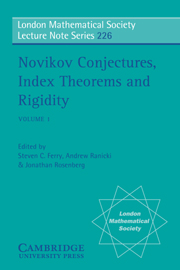Assembly maps in bordism-type theories
Published online by Cambridge University Press: 07 May 2010
Summary
Preface
This paper is designed to give a careful treatment of some ideas which have been in use in casual and imprecise ways for quite some time, particularly some introduced in my thesis. The paper was written in the period 1984–1990, so does not refer to recent applications of these ideas.
The basic point is that a simple property of manifolds gives rise to an elaborate and rich structure including bordism, homology, and “assembly maps.” The essential property holds in many constructs with a bordism flavor, so these all immediately receive versions of this rich structure. Not everything works this way. In particular, while bundle-type theories (including algebraic K-theory) also have assembly maps and similar structures, they have them for somewhat different reasons.
One key idea is the use of spaces instead of sequences of groups to organize invariants and obstructions. I first saw this idea in 1968 lecture notes by Colin Rourke on Dennis Sullivan's work on the Hauptvermutung. The idea was expanded in my thesis and article, where “assembly maps” were introduced to study the question of when PL maps are homotopic to block bundle projections. This question was first considered by Andrew Casson, in the special case of bundles over a sphere. The use of obstruction spaces instead of groups was the major ingredient of the extension to more general base spaces.
- Type
- Chapter
- Information
- Novikov Conjectures, Index Theorems, and RigidityOberwolfach 1993, pp. 201 - 271Publisher: Cambridge University PressPrint publication year: 1995
- 4
- Cited by



